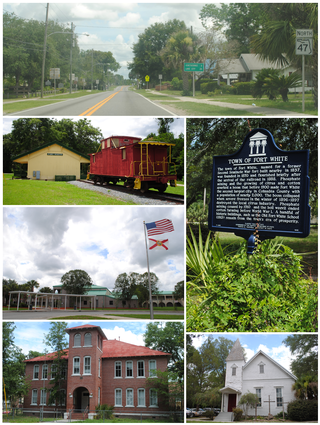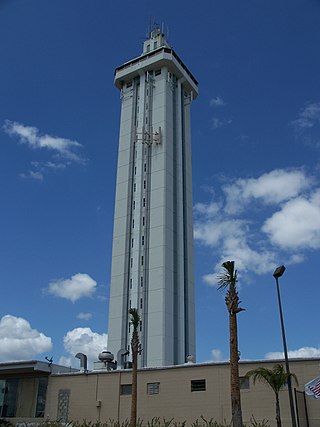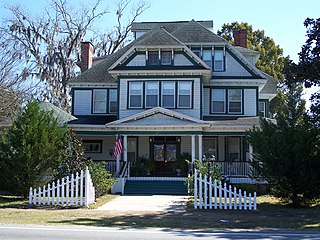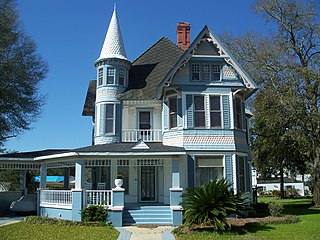
Holmes County is a county located in the northwestern part of the U.S. state of Florida, in the Panhandle. As of the 2020 census, the population was 19,653. Its county seat is Bonifay.

Walton County is located on the Emerald Coast in the northwestern part of the U.S. state of Florida, with its southern border on the Gulf of Mexico. As of the 2020 census, the population was 75,305. Its county seat is DeFuniak Springs. The county is home to the highest natural point in Florida: Britton Hill, at 345 feet (105 m). Walton County is included in the Crestview–Fort Walton Beach–Destin Metropolitan Statistical Area.

High Springs is a city in Alachua County, Florida, United States. It is the fourth-largest city in Alachua County and seventh-largest in North Central Florida. The population was 6,215 at the 2020 census.

Waldo is a city in Alachua County, Florida, United States. It is part of the Gainesville metropolitan area. As of 2020 census, the population was 846.

Keystone Heights is a city located in southwestern Clay County, Florida, United States. It is part of the southwestern most city in the Jacksonville metropolitan area, and is the principal city and primary economic driver of the Lake Region, a region in Florida consisting of southwestern Clay County and parts of Bradford, Putnam, and Alachua counties, known for its many lakes. The city's name is derived from the state of Pennsylvania's nickname, the "Keystone State". The population of the city was 1,446 at the 2020 census.

Fort White is a town in Columbia County, Florida, United States, named after a military fort built in the 1830s. It is the closest town to Ichetucknee Springs State Park. Fort White High School and the Fort White Public School Historic District are located within the town's borders. The original school building was constructed in 1915. As of the 2020 census, the population of Fort White was 618.

Clewiston is a city in Hendry County, Florida, United States. Its location is 80 miles (130 km) northwest of Fort Lauderdale on the Atlantic coastal plain. The population was 7,327 at the 2020 census.

Ponce de Leon is a town in Holmes County, Florida, United States. The Town of Ponce de Leon was named after Spanish explorer, Juan Ponce de León. It is part of the Florida Panhandle in North Florida. The population was 504 at the 2020 census, down from 598 at the 2010 census.

Graceville is a city in Jackson County, Florida, United States. It is near the Alabama state line. A large portion of Graceville's rural acreage is located in Holmes County, Florida, United States. The population was 2,153 at the 2020 census.

Clermont is a city in Lake County in central Florida, United States, about 22 miles (35 km) west of Orlando and 22 miles (35 km) southeast of Leesburg. The population was 43,021 in 2020. The city is residential in character and its economy is centered in retail trade, lodging, and tourism-oriented restaurants and bars. It is part of the Orlando–Kissimmee–Sanford Metropolitan Statistical Area.

Greenville is a town in Madison County, Florida, United States. The population was 746 at the 2020 census, down from 843 at the 2010 census.

Crestview is the largest city in Okaloosa County, Florida, United States. The population was 27,134 at the 2020 census, up from 20,978 at the 2010 census. It is the county seat of Okaloosa County. With an elevation of 235 feet (72 m) above sea level, it is one of the highest points in the state.

Land O' Lakes is a census-designated place (CDP) in Pasco County, Florida, United States. It is part of the Tampa-St. Petersburg-Clearwater, Florida MSA. As of the 2020 US census, the CDP had a population of 35,929.

Auburndale is a city in Polk County, Florida, United States. It is part of the Lakeland-Winter Haven, Florida Metropolitan Statistical Area. The population was 15,616 at the 2020 census.

Haines City is a city in Polk County, Florida, United States. Its population was 13,174 at the 2000 census and 20,535 at the 2010 census. It is the third most populous city in Polk County. It is part of the Lakeland–Winter Haven Metropolitan Statistical Area.

Lake Alfred is a city in Polk County, Florida, United States. It is part of the Lakeland–Winter Haven Metropolitan Statistical Area. The population was approximately 6,374 at the 2020 US census.

Freeport is a city in Walton County, Florida, United States. It is part of the Crestview–Fort Walton Beach–Destin metropolitan area. As of the 2020, the population recorded by the U.S. Census Bureau was 5,861.

The DeFuniak Springs Historic District is a U.S. historic district located in DeFuniak Springs, Florida. DeFuniak Springs, originally Lake DeFuniak, was named after Fred DeFuniak, the chief executive of the Louisville and Nashville Railroad. The district is bounded by Nelson and Park Avenues and 2nd and 12th Streets. It contains 172 historic buildings and 2 objects.

Walton-DeFuniak Library is a historic library located at 3 Circle Drive, in DeFuniak Springs, Walton County, Florida in the United States. Opened in 1887, it is the oldest continuously run library in the state. It is a contributing property in the DeFuniak Springs Historic District. The City of DeFuniak Springs and the commissioner’s office of the city donate funds to the Walton-DeFuniak library in order to keep the library running for patron benefit. While the original Walton-DeFuniak library was opened in 1886, there has been some debate as to exactly which library is the oldest in the state of Florida. Historians will say that the oldest library in Florida is actually located in St. Augustine.

The Crestview–Fort Walton Beach–Destin, Florida, Metropolitan Statistical Area, as defined by the United States Census Bureau, is a metropolitan area consisting of Okaloosa and Walton counties in northwest Florida, with the principal cities of Crestview, Fort Walton Beach, and Destin. As of the 2010 census, the MSA had a population of 235,865, and a 2012 population estimate of 247,665.
































